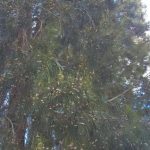A plague of a native geometrid moths (Antictenia punctunculus – no common name) has visited southern Queensland, with huge numbers of moths reported. The species belongs to the twig looper family (Family Geometridae) and occurs in Queensland, New South Wales and the ACT.
The moths have a 35-40 mm wingspan and distinctive colour pattern. The adults are a greyish brown with a darker patch where the forewings attach to the body, a tan brown line extending across the wings and a single small dark brown spot in the middle of each wing. The undersides of the wings look similar to the upper sides, but have twin grey spots outlined in reddish brown visible on the wingtip of each hindwing. The month’s body is about 15 mm long and they hold the wings out wide in a kite-like pose when at rest.

Antictenia punctunculus moths are quite distinctive (upper and lower wing patterns). Photo by Hugh Brier.
Huge numbers have been spotted on trees and public buildings.
- Heritage bank at Kingaroy (Hugh Brier)
- Woolworths supermarket att Kingaroy (Hugh Brier)
- South Burnett Council chambers at Nanango (Megan Nilon)
- Large numbers of dead moths on the ground (Megan Nilon)
- Moths in trees at Nanango (Megan Nilon)
- Large numbers of moths spotted near Pittsworth (Penni Wick)
There is very little information available on this species, including host range. It is likely that its larvae feed on native shrubs, as do other similar species. While it is a relatively common species that is frequently seen in light trap catches at the Joh Bjelke-Petersen Research Station, there are no records of it attacking crops, and it is highly unlikely it is a pest.

Eggs (about 1mm lengthwise) on narrow-leafed ironbark leaves (Hugh Brier) and larva on tree trunk (Angella Griffiths)
Why has it suddenly turned up in such numbers?
The most likely answer is the breaking of the drought. During a drought, many of an insect’s host plants die, causing the insect population to crash. As a result, predators and parasites (beneficial insects) that attack the moth’s larvae find it much harder to find their prey, and so their populations also crash.
When above average rainfalls return, there is an explosion of the moth’s host plants, which can trigger an explosion of moth numbers, if the moth gets a head start on its predators and parasites. Successive generations of the moth can breed rapidly without their larvae suffering the significant mortality (90%+) that is often inflicted by natural enemies. Eventually the beneficial populations will catch up, but in some instances, not before a plague outbreak of the moth/caterpillars occurs.
This end-of-drought phenomena is also observed with some pest species, particularly armyworms. Of note is the 2003 outbreak of dayfeeding armyworms that denuded millions of hectares of pasture in southern and central Queensland. There was even a report of the Bunya Highway being temporarily closed by millions of armyworms marching across it, just north of Kumbia. This was bad news for motorists as their cars spun off the road when their tyres hit the slimy remnants of crushed caterpillars.

Dayfeeding armyworm (Jozef Wessels) and pasture damage in 2003 (DAF Kingaroy)
Should I do anything?
At home there is no need to do anything other than admire these pretty Geometrid moths. They will not do us any harm, and are likely to be a good food source for our native birds and lizards. They will eventually move on, so sit back and enjoy an amazing insect event.
However, bright security lightening in commercial and public areas can attract tens of thousands of moths which do become a hazard. Dead moths need to be swept off walkways so pedestrians don’t take a tumble. In one extreme instance in the South Burnett, there were so many dead moths piled in heaps on the ground that they became fly-blown, resulting in an unpleasant odour.






